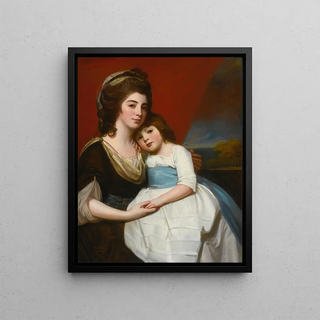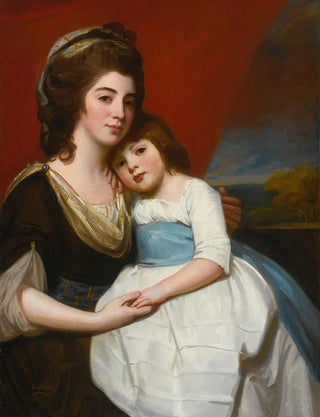Art print | Portrait of Lady Georgiana Smyth circa 1757-1799 and her son - George Romney


View from behind

Frame (optional)
Discover the captivating introduction to this exquisite art print of Lady Georgiana Smyth and her son, painted by George Romney. In the fascinating world of 18th-century English painting, this portrait stands out for its ability to capture not only physical features but also the very essence of its subjects. Dated from the late 18th century, it reflects an era when portraiture was an essential means of asserting social status and family values. Romney's work goes beyond a faithful representation; it offers an immersive experience into the intimacy of a mother and her child, revealing deep and universal emotions.
Style and uniqueness of the artwork
George Romney's style is characterized by unmatched delicacy and meticulous attention to detail. In this portrait, light plays a crucial role, illuminating the faces of Lady Georgiana and her son in a way that enhances their beauty and humanity. The drapery of the clothing, carefully rendered, demonstrates technical mastery that lends timeless elegance to the entire piece. The chosen colors, soft and harmonious, create a warm, almost intimate atmosphere. Every brushstroke seems to tell a story—of a maternal relationship filled with tenderness. This painting is a true ode to motherhood, where Lady Georgiana's gaze, both proud and protective, evokes unconditional love, while the child, innocent and curious, embodies hope and the future.
The artist and his influence
George Romney, born in 1734 in Kendal, is one of the most renowned portraitists of his time. His career, spanning several decades, is marked by a constant pursuit of perfection and an ability to capture the soul of his subjects. Influenced by the great masters of painting, notably Velázquez and Rubens, Romney developed a unique approach that combines realism and idealization. His portraits, often imbued with romanticism, not only shaped the taste of his era but continue to inspire many contemporary artists. The depiction of Lady Georgiana Smyth and her son perfectly illustrates

Matte finish

View from behind

Frame (optional)
Discover the captivating introduction to this exquisite art print of Lady Georgiana Smyth and her son, painted by George Romney. In the fascinating world of 18th-century English painting, this portrait stands out for its ability to capture not only physical features but also the very essence of its subjects. Dated from the late 18th century, it reflects an era when portraiture was an essential means of asserting social status and family values. Romney's work goes beyond a faithful representation; it offers an immersive experience into the intimacy of a mother and her child, revealing deep and universal emotions.
Style and uniqueness of the artwork
George Romney's style is characterized by unmatched delicacy and meticulous attention to detail. In this portrait, light plays a crucial role, illuminating the faces of Lady Georgiana and her son in a way that enhances their beauty and humanity. The drapery of the clothing, carefully rendered, demonstrates technical mastery that lends timeless elegance to the entire piece. The chosen colors, soft and harmonious, create a warm, almost intimate atmosphere. Every brushstroke seems to tell a story—of a maternal relationship filled with tenderness. This painting is a true ode to motherhood, where Lady Georgiana's gaze, both proud and protective, evokes unconditional love, while the child, innocent and curious, embodies hope and the future.
The artist and his influence
George Romney, born in 1734 in Kendal, is one of the most renowned portraitists of his time. His career, spanning several decades, is marked by a constant pursuit of perfection and an ability to capture the soul of his subjects. Influenced by the great masters of painting, notably Velázquez and Rubens, Romney developed a unique approach that combines realism and idealization. His portraits, often imbued with romanticism, not only shaped the taste of his era but continue to inspire many contemporary artists. The depiction of Lady Georgiana Smyth and her son perfectly illustrates






